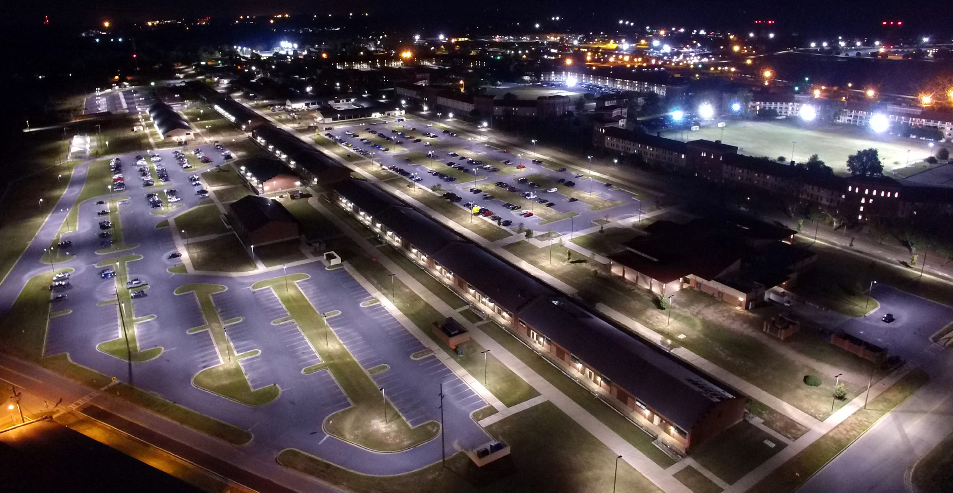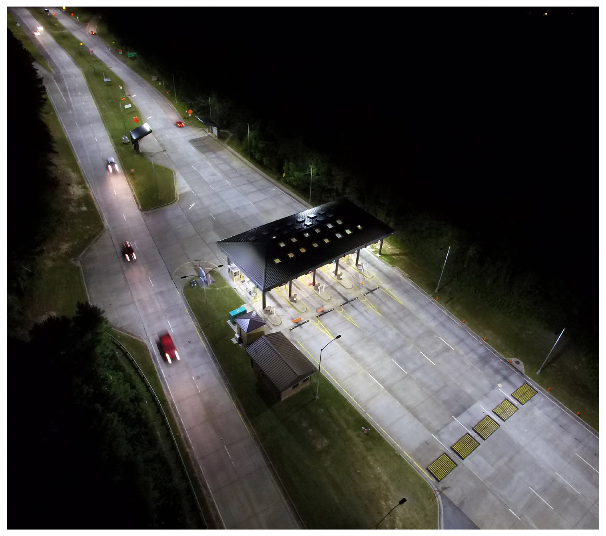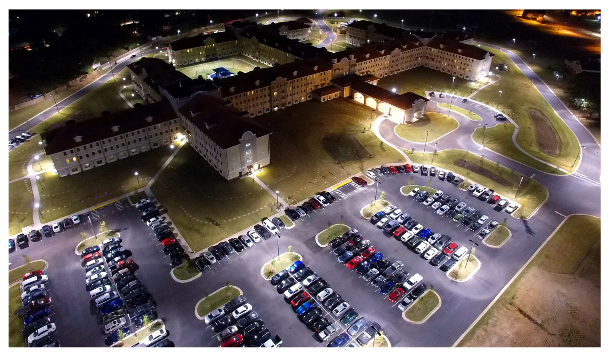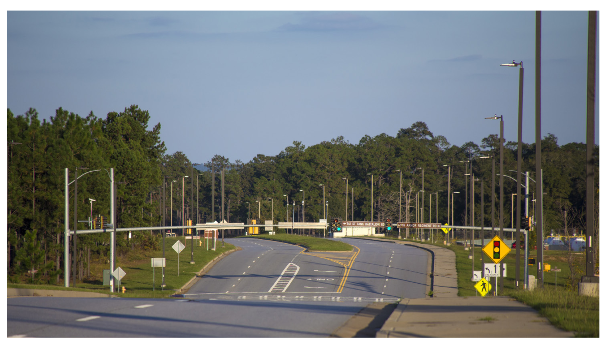The Situation
Luminaire outages represented the most common complaints when Flint Energies purchased the outdoor power system at Fort Benning, a military training base and home to the U.S. Army Maneuver Center of Excellence. Fort Benning, located near Columbus, Georgia, supports more than 120,000 active duty military, family members, reserve component soldiers, retirees and civilian employees on a daily basis.
“As with any military base, security is a tremendous issue and we had maintenance crews working for months to get the existing high intensity discharge (HID) luminaires functioning,” said Walker.
Fricks, Flint Energies manager of Fort Benning operations. “The base often relies on roadway lighting during training and it’s not uncommon to see 500 soldiers running along the streets before dawn.”
 |
Fort Benning under LED lightings from Acuity Brands. (All Photos Courtesy of Acuity Brands)
|
Flint Energies made the decision to convert to LED luminaires based on projected energy and maintenance savings and Department of Defense energy reduction mandates. Flint Energies also worked with the U.S. Army Corps of Engineers, which emphasizes energy efficiency to minimize the Army’s energy footprint. Installing LED lighting helped the Army Corps of Engineers gain LEED certification for various new projects. Fort Benning also has an energy manager on post.
Flint Energies evaluated several luminaires from different manufacturers and selected an LED system based on product quality and cost.
Flint Energies is a not-for-profit memberowned electric cooperative headquartered in Reynolds, Georgia, that provides energy services to residential, commercial, industrial and agricultural members in parts of 17 central Georgia counties. Flint Energies is a Touchstone Energy Cooperative and part of a nationwide family of electric cooperatives exhibiting the core values of integrity, accountability, innovation and community commitment.
Anixter served as the distributor partner for the project. Anixter Power Solutions is a leading global supplier of electrical and lighting solutions to the construction, industrial, public power and investorowned utilities segments.
The Challenges
Lighting challenges encountered at Fort Benning were typical of most military bases. Flint Energies had to consider safety and security on the base as well as the range of applications requiring a broad portfolio of luminaires, including roadways and intersections, checkpoints, medical facilities, parking, and tank and motor pools.
Fort Benning is home and employer for a mix of military personnel and civilians with different schedules and needs. Some soldiers and their families reside in base housing while others – along with civilians – leave the base at 5 p.m. during the week. Still others have jobs requiring them to work through the night.
 |
 |
A total of 3,500 LED luminaires are installed to the base area.
|
Lastly, the military base needed quality, durable and reliable luminaires that could reduce maintenance costs and energy consumption while meeting Fort Benning’s specific lighting needs. Most of the 182,000-acre military base is occupied or in use year round, although areas such as basic training may be closed down during certain times of the year such as holidays.
The Solution
Based on the results of the luminaire test in the parking lot and committee recommendations, Flint Energies worked with Acuity Brands to provide Fort Benning a total lighting solutions package. The LED luminaire installation was completed in phases beginning with roadways and parking areas.
Among the 3,500 LED luminaires installed to date, 2,500 are controlled by Acuity Controls’ ROAM® Enterprise stateof-the-art wireless lighting control and monitoring system with a 100,000+ node capacity. Fort Benning plans to install approximately 3,000 additional Acuity Brands LED luminaires. The base’s energy manager, Mark Fincher, made the decision to use ROAM as the technology. ROAM uses the scheduling of on/off and dim control functions to reduce annual energy and maintenance costs. It also provides comprehensive monitoring & diagnostics to further enhance safety & security of base operations.
At the time of this writing, Flint is working with the base to conduct trials with twostage dimming. Fixtures illuminating structures such as office buildings that are unoccupied at night dim to 75 percent output at 10 p.m. and 50 percent output at midnight. The luminaires return to full brightness at 5 a.m.
Fort Benning will continue to evaluate dimming levels for specific buildings on an individual basis to determine what luminaires to dim and how much to dim them.
The Results
Fricks indicated Illumination levels from the LED lighting system exceed IES recommendations and are equal to or better than illumination levels provided by the former high pressure sodium (HID) system.
Fort Benning has the potential to reduce energy consumption by 60 percent over traditional high-pressure sodium fixtures by using LED luminaires from Acuity Brands and ROAM Enterprise for dimming.
 |
 |
Comparison of the switch.
|
“LED lighting is the only solution for street and parking area lighting at Fort Benning,” said Garrison Commander Colonel Andrew Hilmes. “Reduced energy consumption brings a corresponding decrease in greenhouse gases and better directed illumination reduces lighting pollution during normal operation and when luminaires are dimmed.”
LED luminaires offer a significantly longer life than HID systems (over 20 years in most cases) and eliminate the maintenance time and expense required to change lamps. Fort Benning still has maintenance crews that install LED luminaires or respond to outages caused by storms rather than investing time to change HID luminaire lamps.
“In today’s world, we understand the importance of creating a safe and secure environment while reducing energy consumption and maintenance,” said Rob Drago, Vice President, Infrastructure, Acuity Brands Lighting. “Acuity Brands offers an entire line of lighting solutions with controls to meet the challenges specific to modern “smart” military bases. Luminaires with precisely engineered optics place light where it is needed for quality illumination without waste.”

















